



Lecture 14:
Free Body Diagrams
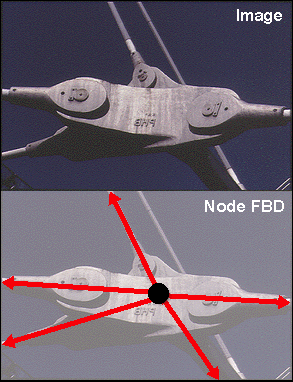
One of the most useful aids for solving a statics problem is the free body diagram (FBD). A free body diagram is a graphic, dematerialized, symbolic representation of the body (structure, element or segment of an element) in which all connecting "pieces" have been removed. A FBD is a convenient method to model the structure, structural element, or segment that is under scrutiny. It is a way in which to conceptualize the structure, and its composite elements, so that an analysis may be initialized.
All of the physical attrributes of the structure are removed. This is not completed at random, rather with a distinct method. A body, or segment thereof, is represented by a simple single line. Each connection is solely represented by a juncture with distinct properties, or is replaced by a set of forces and moments which would represent the action at that connection. Internal forces which would be found at a node (connection or joint) can be replaced by representational external forces where that "part" connects would connect with the other member in the FBD. All loads are represented as force systems.
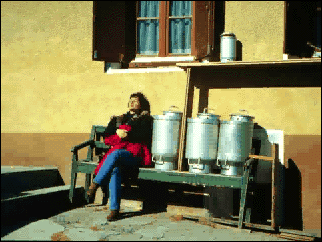
The image to the right is a link to amovie which illustrates the way in which each of the loads on the structure (in this case the bench) are resolved. It also illustrates how each and every physical load that acts upon the structure must be represented. This means that all of the loads are replaced by vectors. Even the supports are replaced by single vectors.
Notice how the person, cans and upper shelf dematerialize and are replaced by vectors. The FBD at the end of the movie is not complete. What is missing?
Everything that is needed to solve a force system is included on the FBD. Free body diagrams may not seem necessary in the relatively simple current applications, but as problems become more complex, their usefulness increases.

The following is the process for determining the reaction at the wall for a cantilever beam. A FBD is first drawn of the beam. Next, cut the beam free from the wall and replace the wall with the forces that were supporting the beam at the wall before it was cut free. These forces are unknown, but they are the only forces that can keep the beam in equilibrium. They are identical to the internal forces in the beam at that point before it was cut. The internal forces in the beam before it was cut free from its support are also determined when the forces which will keep, or put, the FBD in equilibrium are found.
A fixed support will resist translation in all directions and rotation (moment). The FBD must show all of these directions. The principles of equilibrium can always be used to solve a FBD. In the FBD above Sum Fy = 2K and Sum Fx = 0. The 2K forces (load and vertical reaction force) cause a counter-clockwise couple of 10 K-FT which must be resisted by a moment on the end of the cut section of 10 K-FT acting in a clockwise direction.

This is an illustration of three different structural systems which have one 100 pound load and one 150 pound load acting on them at exactly the same point. They are also supported with a roller support at the left and pinned support at the right. Each one could be a structure made of any type of material.....wood, steel, bamboo, or perhaps paper.
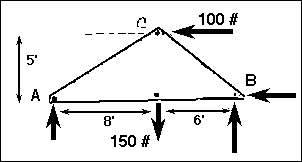
This is a Free Body Diagram of these three systems which has been drawn to represent the force system. Note how all of the internal structure has been removed from this representation. The internal arrangement does not matter for the determination of the supporting reactions! AND, if the supporting and loading geometries are the same, the external reactions will alsways remain the same.
The Umbrian Street Lamp
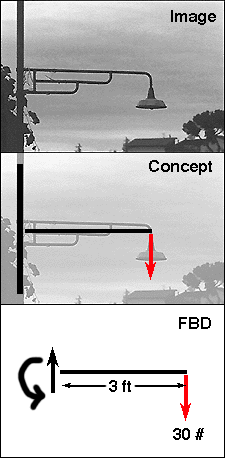
The Verona Column
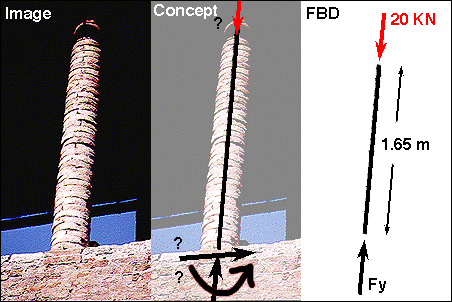
There are many situations in which the exact conditions of the end restraints are not able to be determined in the first glance. The materiality and relative stiffness of the elements which are being supported/connected provide clues as to the actual behavior.
This is a thin brick column supporting a wooden canopy at the old castle in Verona, Italy. How is this element connected to the wall below?
Most likely one would model this behavior as a simple connection. The masonry would have a very difficult time transferring moments since it cannot develop the required tensile half of the couple. The mortar would also most likely yield if a lateral load of significant force were to be applied. However, one could argue that the column can, and certainly does, resist a small amount of lateral load. And, due to the force of gravity pulling each brick down there could be the possibility for the base to begin to resist a moderate moment as long as the tensile force does not exceed the compressive force due to the self-weight of the structure. So, where does this leave the FBD? In the hands of the designer to make a choice on the type of model that he/she desires.... What is the correct model? It depends.
The Harbor Crane
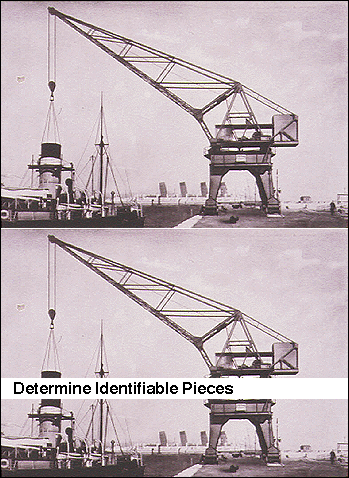
When confronted with what appears to be a complex prolblem, the first thing to do is to SIMPLIFY!!!Determine the identifiable pieces. Look for significant changes in the structural morphology. Turn the image upside down if need be in order to attempt to dematerialze the problem.
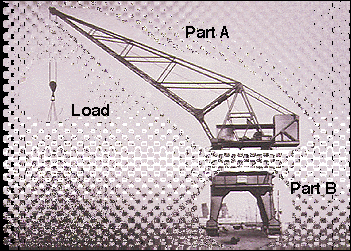
In this case the crane must be divided into recognizable pieces. Here it has a truss upper structure and a rigid frme lower structure. Two significant weights, or forces, can be identified acting on part A; the weight of the hoisted load and the large concrete block counter-balance. Notice the relative magnitudes of the force vectors. What influence does this have on the total capacity of the crane? How might this crane fail? What element might fail first?
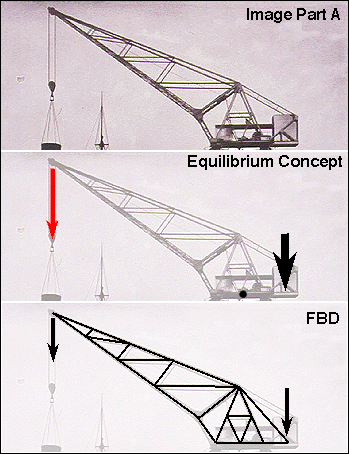
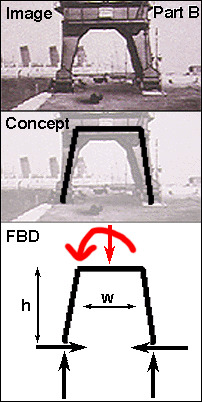
 Reactions of a Beam
Reactions of a Beam
 Horizontal Components of a Reaction
Horizontal Components of a Reaction
 An example
An example
 Another example
Another example
 Another example
Another example
Questions for Thought
How would the FBD be completed for the anchor blocks for Frei Otto's tent structure?
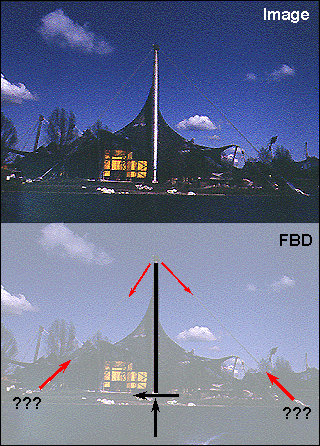
Homework Problems
Additional Reading
Seward, Derek. Understanding Structures. Macmillan Press (London). 1994. pp. 18 - 24.
Copyright © 1995, 1996 by Chris H. Luebkeman and Donald Peting
Copyright © 1997 by Chris H. Luebkeman



















